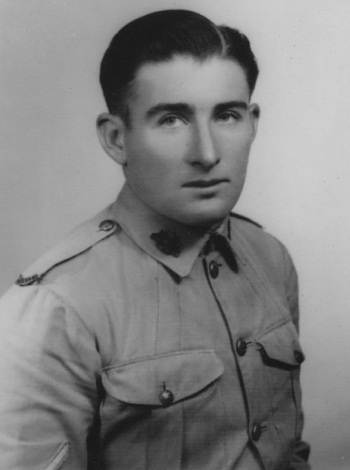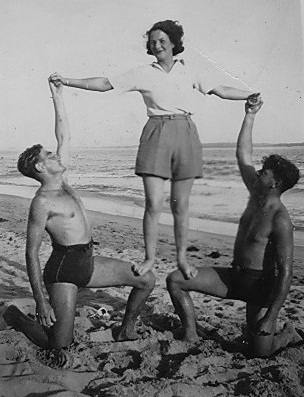

2/22nd Battalion
Date of Birth: 14 July 1918
Place of Birth: Cowell, Eyre Peninsula, South Australia
JACK MILLS (Gunner; Lance Bombardier, Lark Force) 1918—1942
BESS FLORES (NÉE MILLS) VICTOR HARBOR SA and BRUCE MILLS, TUMBY BAY, SA
Jack Mills was born in Cowell, Eyre Peninsula, South Australia on 14 July 1918. The 4th son and 5th child in the family of 11 children of Richard Surguy and Barbara Mary Mills (née Hogg), Jack lived on family properties in Carpa, Cowell, Elbow Hill and Myola Station near Iron Baron and worked as a shearer, mostly on farms and stations on Eyre Peninsula.
He enlisted in the Australian Permanent Forces at Adelaide SA on 13 January 1940, and was allotted Army Number SP 6530. He transferred to the AIF on 25 February 1941, was allotted Army Number SX11448 and served in Australia with the 10th Australian Heavy Artillery Battery. As a member of L Battery, Lark Force, he embarked at Sydney NSW on 18 April 1941 for service in Rabaul.
When Rabaul fell to the Japanese in January 1942, Jack was captured. Later in 1942 our parents received a heavily censored letter, one of those dropped over Port Moresby saying that he was OK, and that our mother was not to worry.
Later still, the Red Cross informed our parents that Jack was in Changi.
After the war, we received further advice. When our cousin, the late Hirrell Mills, was Matron of the Mount Gambier Hospital, one of her patients was an ex-Rabaul soldier who was suffering from severe depression. He and Jack had been in the same small group trying to escape, and Jack, who was too ill with malaria to walk, had begged them to leave him, rather than try to carry him and thus increase the risk of capture.
The patient had escaped and had been picked up in a small boat off the coast and returned to Australia, but the fact of having had to leave Jack had contributed to his depression. He was therefore relieved to hear of Jack’s letter but as we don’t now know who he was, we can only hope that he recovered, and thank him for sharing his story with us.
In another development, in 1945 or 1946, a minister of religion who had also been captured but had returned to Australia, visited our by then widowed mother in Iron Baron. He told her that he knew Jack and was certain that he had seen him embarking on the Montevideo Maru. Again, we don’t know the name of this good man who took the time and trouble to travel unmade roads to find our mother, but from information received from Lindsay Cox, we think it must have been the late John May, whose family we thank.
His information contradicts the Red Cross statement, as does further research by Anne and Jim Scott at the Kranji War Memorial in 1989, and by Frances Poole in 1990. They found no record of Jack having been in Changi. We hope therefore that the Japanese card indexes will eventually arrive at the Australian War Memorial and that they will help to resolve the mystery.
Jack’s story is based partly on family memories, but mostly on research done by our eldest sister, the late Joan Mary Jenkins, née Mills, for her family history From whence we Inherit. (Privately published, 1988).
We are seeking the permission of her family to provide the Rabaul and Montevideo Mary Society with relevant extracts from the book and other records of her research.
In the meantime, we hope that Jack’s set of Rabaul photos, which would have been taken between April 1941 and January 1942, will interest many, and may even be recognised by relatives and old friends. They are in the possession of Jack’s second sister Margret Warren, née Mills, and were supplied by Dr Lachlan Warren.




The ship in the background of this photo is the Macdhui.
Photo: Jack Mills Collection
